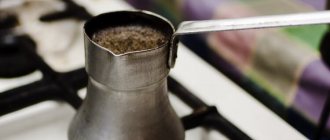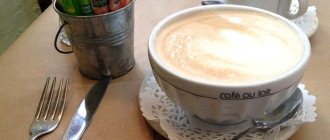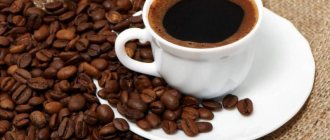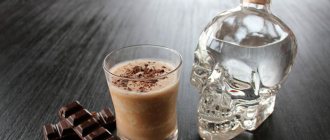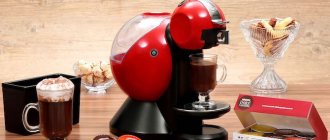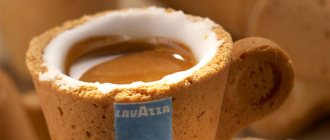In Italy, macchiato is considered an after-dinner drink, since cappuccino is usually drunk there in the first half of the day.
The word "macchiato" is of course Italian and translates to "oh", which gives us a starting point for understanding the essence of the drink. Both basic versions of macchiato (espresso macchiato and latte macchiato) have such a “coloring” of one ingredient by another: either milk inclusions appear on the surface of the coffee, or we see a speck of poured coffee on the milk foam cap. We will explain why there are two options below, but for now remember that in the case of macchiato, the name means “colored” and not “completely changed color.” That is, you should only slightly supplement the drink with one of the ingredients, and not mix everything in a 1:1 ratio.
Special differences between macchiato
Coffee macchiato is a strong espresso with milk, prepared in such a way that the layers of ingredients do not mix, and the container is topped with airy foam. The cooking technology is based on the temperature difference between liquids, due to which they do not mix with each other. To convey the beauty of this drink, it is served in transparent tall glasses.
It is difficult to accurately describe the ratio of milk and strong coffee in a serving of macchiato due to the fact that different countries have their own views on this drink. So, in Italy they prepare a very strong macchiato, consisting of 70 ml of espresso and 15 ml of milk with milk foam. Double espresso with a small portion of milk is often used. Cuisines of other countries prepare a less strong drink, and use both cold and hot milk.
The recipe for “stained coffee,” as macchiato is also called, can include various syrups, spices, and sugar. Its thick foam can serve as the basis for latte art. The main distinguishing feature of the drink is that when preparing, milk is first poured in, and then hot coffee is poured in a thin stream over a spoon. If you do it the other way around, you get a latte.
Features of frothing milk for macchiato
To prepare a macchiato, you need to whip the milk into a homogeneous foam. Pasteurized milk froths best when cooled to +4 °C. You can use either a mechanical or automatic cappuccino maker.
Milk is poured into a metal pitcher. The nozzle of a mechanical cappuccino maker is buried 0.5 cm into the liquid. As whipping proceeds, the jug is lowered: the nozzle should always be at approximately the same distance from the surface. When the foam level is 3–4 cm below the edge of the pitcher, the steam generator is lowered to the bottom.
The pitcher is supported with his palm on the bottom. Whipping is stopped when the milk temperature reaches approximately +60 °C and the metal becomes so hot that it becomes uncomfortable to hold.
To compress the foam, the pitcher with whipped milk is raised 2-3 times 30-40 cm from the table surface and placed on it again. Then, to separate the foam from the milk, make 2-3 rotational movements with the pitcher.
History of creation
This coffee drink began its march around the world from Italy, and after some time it conquered the whole world with its unusual taste and appearance. But why such a strange name?
Macchiato is an Italian word that translates to “spotted” or “marked.” This name was not without reason, because the drink actually looks like it has spots; its coffee chains (layers) are clearly visible.
This look is achieved thanks to a special technique of mixing milk and coffee. In the usual classic recipe, milk is added to the already prepared coffee, but in the macchiato coffee recipe the opposite is true. First, the prepared frothed milk is poured into the cup, and only after that the coffee itself. And it turns out that the coffee seems to drown in foam and leaves spotty traces behind it.
Fundamental differences from latte coffee
By now, most people will be able to answer the question “What is a latte macchiato?” After all, it is quite easy to recognize him.
Visual difference
If the cocktail is served in a glass container, then the transition from milk to coffee is clearly visible through the walls. This splendor is crowned with lush foam.
Differences in the selection of ingredients
The classic recipe involves using only Arabica beans. Excelsa is sometimes added to the mixture to add fruity notes to the drink. You should not replace Arabica beans with more expensive varieties; milk will still overwhelm their taste and dominate.
By production
In a latte macchiato, unlike other types of coffee, the frothed milk is poured into the glass first and only then the espresso. It is important to fill your hand so that they practically do not mix, so that a beautiful gradient is formed.
Taste
This is the least strong compared to other coffee drink options. Although the base is espresso, its bitterness is offset by a large amount of milk.
Types of macchiato
Based on the temperature of the finished drink, Freddo and Caldo macchiato are distinguished. The first recipe uses cold milk, and the second uses hot milk. The essence of the drink does not change - it is still a small cup of strong coffee with milk.
This is how milk for a macchiato should be
Conventionally, a distinction is made between latte macchiato and espresso macchiato. Here the division is based on the volume of milk, in the first case 3 parts of milk and 1 coffee are used, in the second - 2 parts of coffee and 1 milk. Macchiato may differ in taste and strength depending on the type of coffee beans and the degree of roasting. Usually they use Arabica or a mixture of Arabica and Robusta, deeply roasted.
Manufacturing secrets
It is imperative to know about all the features of making macchiato coffee, otherwise you can get a completely different drink, consisting of some of the same ingredients.
The main distinguishing feature of this type of coffee is its layering. It is important to maintain the correct order of layers and avoid mixing them.
Milk is always added first, and coffee is poured on top of it. Changing the order is strictly prohibited!
In order to prepare the drink, you must use strong dark coffee or espresso. You can also use ground coffee, but coffee lovers warn that the natural taste and smell will be less pronounced in this case.
It is best if you take milk with the highest fat content. The perfect percentage is 6%. But you can take less.
Calorie content
100 ml of drink contains approximately 54 kcal. Calorie content may vary depending on the fat content of the milk. When adding sweet ingredients - syrup, sugar, liqueur - the calorie content of coffee will be quite higher. For those watching their figure, it is not recommended to overuse the addition of various “sweet” ingredients. The daily dose of coffee consumption should not exceed more than 5 cups. In Italy, Macchiato is drunk exclusively in the morning.
Difference between macchiato and latte
Many people confuse macchiato with latte; these drinks are really similar in taste, but there are some differences. The order in which the milk and coffee are mixed plays a decisive role. If you add milk to a cup of coffee, you get a latte. In addition, more milk is added to the macchiato.
There are two types of macchiato: espresso macchiato and latte macchiato. The first drink is a mixture of milk and coffee. The second type is prepared by adding coffee to frothed milk. There are also differences in milk temperature. Freddo – coffee macchiato with the addition of cold milk. Caldo is a drink made with hot milk.
Varieties
There are several subtypes of coffee macchiato, and the name depends on the temperature at which the milk is used. If it is cold, the drink is called “Macchiato Fredo”, and if it is hot, then “Macchiato Caldo (Caldo)”.
It is quite common to add various syrups, liqueurs and cocoa to improve the taste. By adding caramel (usually caramel syrup is the first bottom layer), you can get a delicious caramel macchiato.
A classically prepared macchiato is called “Espresso macchiato”, and “Latte macchiato” is a regular latte, only with a modified technology for mixing ingredients. First, pour out the milk, and only then the coffee, so that a characteristic scattering of coffee stains forms on the surface. In this case, there is no need to apply foam on top.
Cooking recipes
Traditionally, coffee macchiato is made from 50 ml of frothed milk and 25 ml of strong espresso. The milk is heated to 70 degrees and whipped into thick foam, poured into a cup or glass, and espresso is carefully poured over a spoon in a thin stream so that it is above the milk, but under the foam. The milk temperature should be lower than the espresso temperature.
It is better to froth the milk in a coffee machine using hot steam, so it will turn out to be the correct consistency. If this is not possible, the milk is heated to 70 degrees and whipped in a blender or using a mixer.
Traditional serving of macchiato in a cafe
There are many variations of macchiato with the addition of chocolate, spices, and syrups. To make a latte macchiato, you can use the following recipe:
- prepare 100 ml of milk with 2-3% fat content;
- brew 70 ml espresso;
- pour half of the cold milk into a tall glass, heat the other half and whisk until foamy;
- Pour hot espresso into the cold milk, spoonful at a time, and warm whipped milk on top.
If desired, espresso is brewed with sugar, and chocolate chips are used as decoration.
Caramel coffee macchiato has an original taste; the recipe is as follows:
- brew 80 ml espresso;
- heat 200 ml of milk, add 2 tsp. vanilla syrup and beat with a mixer until foamy;
- Prepare 2 glasses, fill them with whipped milk and pour in espresso by spoon;
- Gently pour 2 tsp on top in thin streams. caramel syrup per glass.
The syrup can be prepared at home. It is stored in the refrigerator and used not only for coffee, but also for various confectionery products. For the syrup, mix 250 ml of water and 200 g of sugar in an enamel bowl, stir, pour in 1.5 ml of vanilla extract, bring to a boil and cook over low heat for 5-8 minutes, cool and store in a glass container.
Thick caramel is added for taste, smell and decoration.
Macchiato can be prepared with cocoa, cinnamon and other not too aggressive herbs or spices. The brewing technology is simple: spices can be added to the coffee pot when brewing espresso or directly into the cup before pouring in the frothed milk. It is recommended to sprinkle cocoa on top of the finished drink for aroma and decoration.
You can prepare a macchiato in a coffee machine in just a couple of minutes. For this purpose, ground coffee capsules are used. BOSCH Tassimo coffee machines produce capsules with coffee and a milk component, so you can now prepare different types of drinks without any problems. To do this, coffee and milk capsules are loaded sequentially. The range of capsules is quite large, so you can choose a drink based on your preferences.
Spotted coffee with a masculine character
Once upon a time in Italy, history, however, is silent about exactly when, one man ordered coffee with milk. But he clarified that he did not want cappuccino. The barista decided to simply add a shot of espresso to the frothed milk. Sprinkles of coffee drink appeared on the surface of the milk foam. The man noticed this and exclaimed in surprise: “Macchiato?” Since then, this name has been firmly attached to this type of coffee. There is an opinion that a coffee drink containing foamed milk is more suitable for the fair half of humanity. However, this is definitely not about coffee macchiato. Due to the high concentration of caffeine and sufficient strength, it has truly become a real man's drink. However, this only applies to the Italian variation of this coffee, which includes a double serving of espresso for one serving of milk. If we talk about the classic version, then the ingredients are taken in equal proportions 1:1. We will talk about what other types of macchiato there are next.
Such a different coffee macchiato
There are many varieties of spotted drink. Here are just the main ones:
- Espresso macchiato
- Latte macchiato
- Fredo macchiato
- Caldo macchiato
Espresso macchiato is considered just the classic version of the drink. The technology for its preparation is as follows:
- First you need to brew one shot of espresso.
- Then we take high-fat milk and heat it.
- Beat the milk with a mixer until it forms a uniform foam on the surface.
- Warm up a cup or glass goblet and pour milk into it.
- Slowly, preferably using a sharp knife, pour in the coffee.
Then the coffee seems to sink into the milk foam, leaving only dark-colored specks on the surface. Due to them, it got its name. Latte macchiato is prepared according to the principle of preparing a latte, but the foam is not placed on top of the drink. It turns out that the technology for preparing spotted coffee is preserved, but the basis is warm milk and milk foam into which espresso is poured. Milk in relation to espresso acts in a 2:1 ratio.
So we looked at the main macchiato drinks. But what then are Fredo and Klado? They differ from each other only in the temperature of the milk. So in the first case, cold milk is used, making Fredo pleasant to drink at lunch in hot weather. Klado, in turn, is prepared from very hot milk, and it is ideal for a frosty morning.
Nutritionists do not recommend drinking macchiato on an empty stomach, but you should not drink it after a heavy meal. Because the milk contained in the drink lowers the acidity in the stomach and reduces the quality of digestion. The best time to serve this drink is between meals in the morning with a small portion of dessert, or an hour after breakfast.
Starbucks Caramel Macchiato
Probably every coffee lover comes to Starbucks sooner or later. But how to prepare their legendary drinks at home?
Today we're looking at their Caramel Macchiato recipe:
- Pour 1 tsp into the bottom of the glass. liquid caramel.
- Add 1 tsp. Sahara.
- Then pour in a double portion of espresso (60 ml).
- Stir the drink well.
- Pour warm milk into an Irish glass.
- Then pour in the resulting caramel drink.
- Place a top of whipped cream.
- Decorate the drink with liquid caramel, cinnamon and chocolate chips.
- We insert a wide straw into the cocktail and get a classic drink from Starbucks.
How to make coffee macchiato at home
It’s difficult to get a classic macchiato without a coffee machine, but anyone can make a similar drink.
What will you need?
- Strong coffee prepared in a cezve or French press, at the rate of 2 teaspoons of ground coffee per 100 ml of water.
- Milk. The higher its fat content, the easier it is to whip it and the more delicate the taste of the finished drink.
How to cook?
- Brew strong coffee.
- Heat the milk slightly in the microwave.
- Beat the milk using a whisk or blender with a whisk attachment. Beat until foam forms on the surface.
- Pour the milk into a warmed cup.
- Carefully—you can use a thin knife—pour the prepared coffee into the milk.
There should be coffee stains on the surface of the drink.
This macchiato should be served and drunk immediately; the foam at home is unstable and falls off quickly.
How to serve and drink
Any coffee with milk is not recommended to be taken after a hearty meal, as such a combination slows down digestion. As already mentioned, Italians prefer their macchiato for breakfast. The ideal time for this would be the break between early breakfast and lunch.
Such a tasty and aromatic drink will be a wonderful accompaniment to a sweet dessert. Agree, it will be difficult to resist such a temptation, but do not get carried away, as this can have a detrimental effect on your figure.
The drink is served in a glass so that guests can enjoy not only its taste, but also its beautiful appearance. The glass comes with a straw through which you can drink the drink. It is also acceptable to serve in a volume of 250-300 ml with a long spoon.
Fans of coffee and coffee drinks can safely include macchiato in the list of their favorite recipes. It is easy to prepare, the list of ingredients is simple and accessible, and it will take a little more time to prepare than the traditional version.
Caffeine Level
All three drinks contain the same amount of caffeine per serving.
For example, cappuccino and latte are made using a shot of espresso and thus contain the same amount of caffeine.
In fact, the average 475 ml cappuccino and latte contain about 173 mg of caffeine (, ).
Meanwhile, 60 ml of macchiato contains about half as much caffeine - just over 85 mg per serving ().
Summary:
Cappuccinos and lattes each contain 173 mg of caffeine per 475 ml serving, while a macchiato contains only 85 grams of caffeine per 60 ml serving.

